S46 Class 4-4-0 1900-1903
1860-1900
D56 Class 4-4-0 1903-1911 (plus rebuilds)
1790-1859
H88 Class 4-4-0 1923 (plus rebuilds)
1780E-1789E
LNER Classes D-14, D-15 and D-16
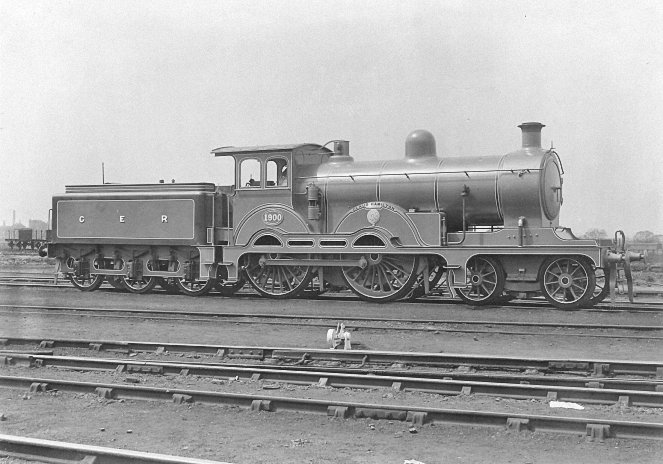 GERS Collection 7002/68
GERS Collection 7002/68
Towards the end of the 1800s there was a general increase in the weight of the longer-distance passenger trains due to the introduction of bogie carriages with corridors, lavatories and so on, and larger and more powerful locomotives were required. Much of the design of the new Great Eastern engines was devolved to F.V. Russell and – as with the P43 class 4-2-2s (q.v.) – Russell produced a design that, at the time, was nothing like any GER locomotive before it. The design was an inside cylinder 4-4-0 with slotted valances reminiscent of the London & North Western 4-4-0s, a large cab with two windows in each side, and a smokebox door of a new heavier pattern in which the conventional hinge straps were replaced by a polished steel ring encircling the door, similar to that used many years before on the London & South Western. The engine was oil fired, and a revised version of the ‘watercart’ tender was fitted. The prototype locomotive was built to Letter Account S46, and as it was due to be completed early in 1900, it was decided to exhibit it at the Paris Exposition to be held to mark the dawn of the new century. Unusually for the GER the locomotive was named Claud Hamilton after the Chairman of the GER, and it was given the running number 1900 in commemoration of the new century. The locomotive is seen here shortly after completion, painted in ‘photographic grey’.
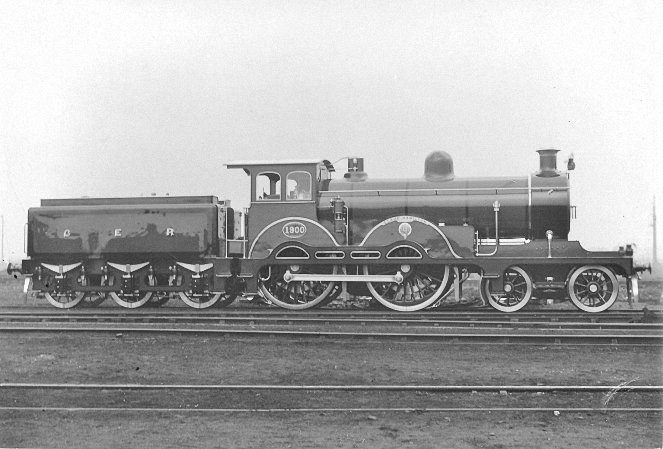 GERS Collection 7002/67
GERS Collection 7002/67
This photograph shows the engine as painted in GE blue livery and in its special exhibition finish, ready for shipping to Paris. The engine – and those that followed – carried hand-painted cast GER crests on their driving wheel splashers. The locomotive was subsequently awarded the Gold Medal at the Paris Exposition. Meanwhile, a further ten engines numbered 1890-1900 were completed, and they proved to be a most successful express passenger design. Because the number 1900 was around 850 more than the highest GER locomotive number used so far, subsequent batches of the class were numbered in groups of ten, backward from 1900: 1890 to 1899; 1880 to 1889, and so on.
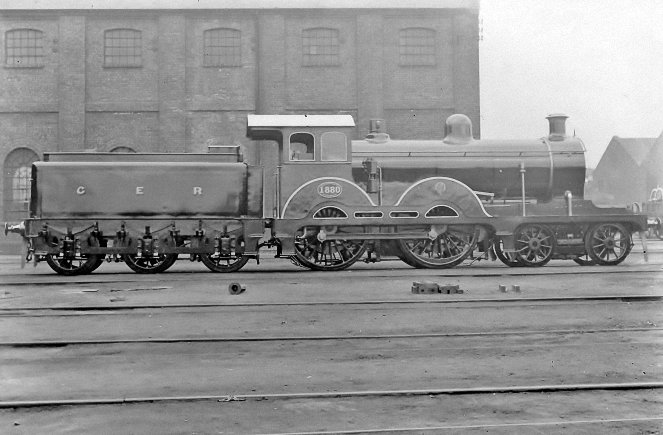 GERS Collection 7002/70
GERS Collection 7002/70
Apart from the oil burning gear, the new 4-4-0s had air-operated reversing gear of a type that proved to be one of the most reliable and positive in action, for the operating gear was ‘overlaid’ on the conventional reversing gear, which meant that once set it remained in position and did not ‘creep’, and it could be operated by hand even if there was no air supply available. The sanding was operated by a twist sleeve on the regulator handle, and forward or reverse sanding was automatically selected according to the setting of the reversing gear. The photograph shows No. 1880 of the next batch to be built – these featured wider cabs with a higher roof.
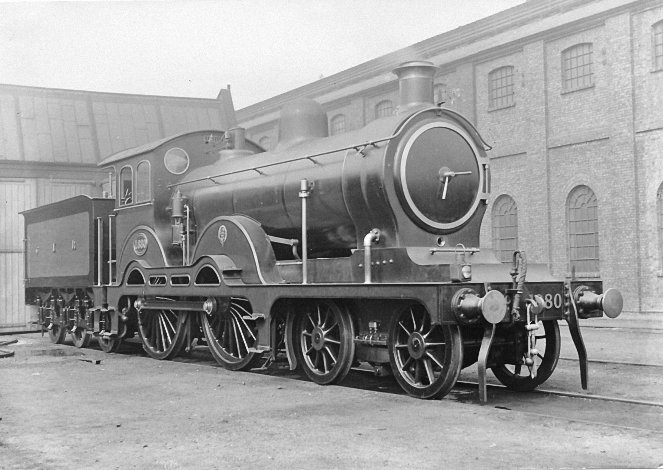 GERS Collection 7002/71
GERS Collection 7002/71
At the same time as the 1880-1889 batch appeared, it was becoming apparent that the 2790 gallon ‘watercart’ tenders held insufficient water for the heavier passenger turns. Accordingly, a new larger tender was designed, holding 3450 gallons, and these were quickly fitted to the 1880-1889 batch and all subsequent locomotives. No. 1880 is again seen here posed outside the Paint Shop at Stratford with its new tender. This picture shows to advantage the air intake for the oil burner, just below the smokebox door. The pipe between the smokebox and footplating carried the heated air to the burners, and also shrouded the exhaust from the Westinghouse brake pump.
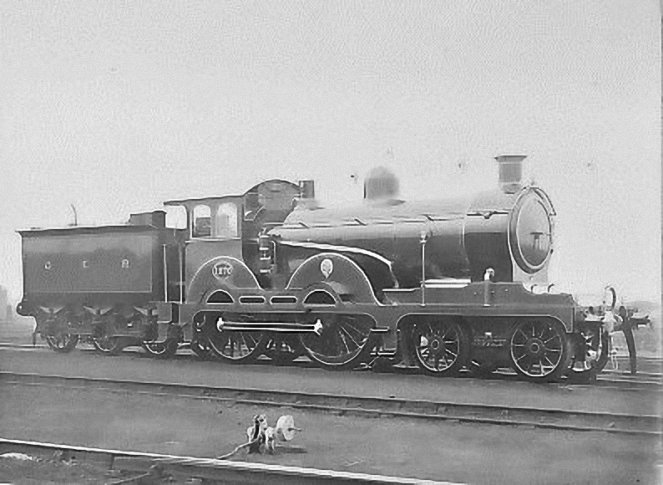 GERS Collection 7062/14
GERS Collection 7062/14
The following two batches of engines were numbers 1860-1879 and included further refinements, most noticeable of which was a change from the circular front cab spectacles to a similar shape to the side windows, with the inner corners shaped to the firebox. This is No. 1870, completed in March 1902.
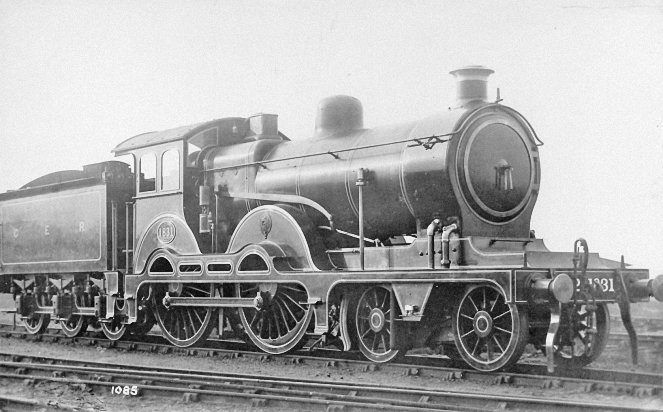 LPC 1147/GERSHC 7005/23
LPC 1147/GERSHC 7005/23
The remainder of the engines built between 1903 and1911 were fitted with Belpaire boilers. In all, seventy of this type were built, beginning with nos. 1850-1859, and they were all essentially identical and known as class D56. By this time oil-burning was being abandoned, and these locomotives were all conventionally coal-fired, and most of the existing S46s had been converted. This is No. 1831 built in 1908, and this view shows the ash ejector gear consisting of a hopper beneath the footplate, connected to the smokebox by an additional pipe. These ash ejectors were carried by all engines of the class in the period in the period from around 1907 to 1911.
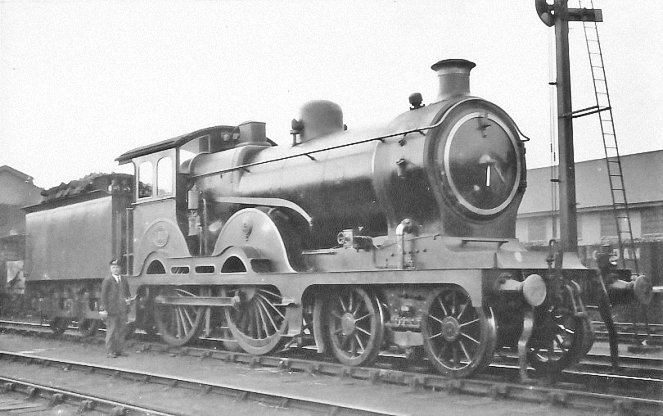 T.G. Hepburn/GERSHC 7018/197
T.G. Hepburn/GERSHC 7018/197
Four of the last batch of D56 4-4-0s built in 1911 were fitted with superheaters as an experiment – two with 18-element Schmidtt gear, and two with the Great Western Railway 12-element type, complete with jumper blast-pipes. From 1914, superheaters were progressively added to the D56s, although by this time the Great Central Railway ‘Robinson’ pattern had been adopted as standard. Experiments were conducted to establish the best method of keeping the elements cool when the regulator was closed: the locomotive shown in the photograph has both the earlier draught retarder, seen on the smokebox side, and the anti-vacuum or ‘snifting’ valves to the rear of the chimney. The snifting valves became the standard fitting. Note also that by the time of the photograph the locomotive has lost its ash ejector gear, and it also carries an experimental boiler with top-feed to the dome. From 1915 it was decided to fit the Belpaire boilers to the S46 class engines as well. These rebuilds had to have their rear frames modified to fit, whilst their cabs and other equipment were brought up to standard with the D56 class so that they were otherwise identical. By the time of the 1923 Grouping into the LNER 20 of the S46 class had been rebuilt as D56s, fifteen of these with superheaters, whilst 34 of the seventy original D56s were superheated. The S46 class engines still with round-topped boilers became class D-14, whilst the D56s and rebuilds from S46 were class D-15.
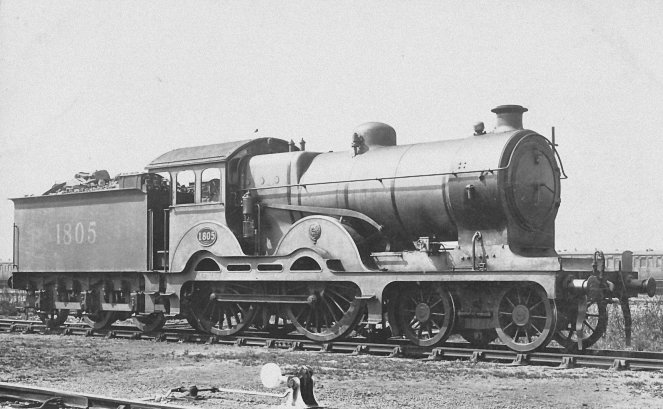 GERS Collection 7005/47
GERS Collection 7005/47
By the early 1920s track improvements had taken place – especially on the Clacton line – and it was decided to fit larger boilers to the ‘Clauds’. The new boiler was of the same large diameter as that used on the S69 4-6-0s of 1911 (q.v.), with a 21-element superheater. At the same time it was decided to build ten new 4-4-0s with this boiler, the H88 class. The first engine appeared within months of the 1923 grouping – this was ex-D56 class rebuild No. 1805, seen in the photograph, out-shopped in full GER wartime grey livery with ‘Train Control’ numerals. The ten new engines followed, numbered 1780-1789 and delivered in the new LNER green. These ‘Super Clauds’ were LNER class D-16.
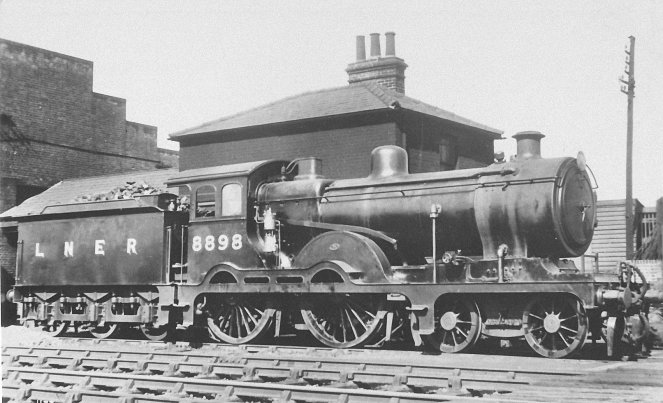 LPC 1029/GERSHC 7005/24
LPC 1029/GERSHC 7005/24
From the mid-1920s the D-15s and D-16s were progressively fitted with extended smokeboxes, as demonstrated by No. 8898 as running in the early 1930s. The engines thus modified were classified D-15/2 and D-16/2, and the un-modified ones D-15/1 and D-16/1. This engine shows the additional coal guards that were added to the tenders. This was one of the original S46 engines 1890-1899 that had their sandboxes allied to the splashers. When rebuilt to D56 the sandboxes were moved below the footplate, but the leading footsteps remained in the forward position, as seen here. Meanwhile, rebuilding of the D-15 class to class D-16 continued, but only those engines originally built as GE class D56 could be converted. The remaining original S46 class were progressively rebuilt with Belpaire boilers as class D-15, but their modified frames were not capable of being fitted with the larger boiler of the D-16s.
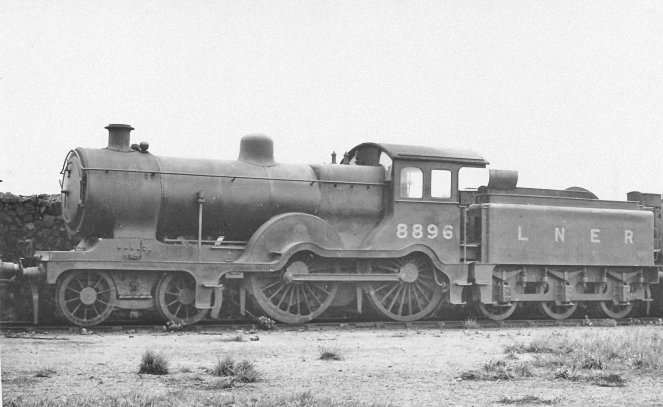 C.L. Turner/GERSHC 7005/43
C.L. Turner/GERSHC 7005/43
Two of the D-15/2s had their decorative valancing removed: No. 8885 as an experiment, and No. 8896 seen here after an accident. This engine still retains its ‘watercart’ tender. Note that this type of tender was only fitted with one coal guard, on the opposite side to that seen here. This engine has also been fitted with pop safety-valves.
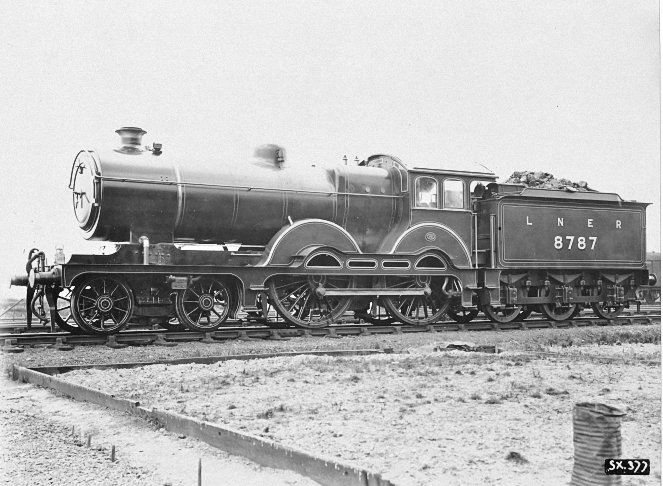 National Railway Museum SX 377/GERSHC 7002/88
National Railway Museum SX 377/GERSHC 7002/88
No. 8787 was one of the new H88 (D-16) locomotives built in 1923. It is seen here in 1928 following the fitting of an extended smokebox. This engine – and class-mate 8783 – were selected as Royal Train engines for journeys to and from Wolferton for the Sandringham Estate. Stationed at Cambridge, they were otherwise frequent performers on the Cambridge – Kings Cross trains. The engines rebuilt from the D-15 class were to all extents identical, except that the footplating had to widened at the rear to accommodate the wider cab, whereas on the ex-H88s it was wider throughout.
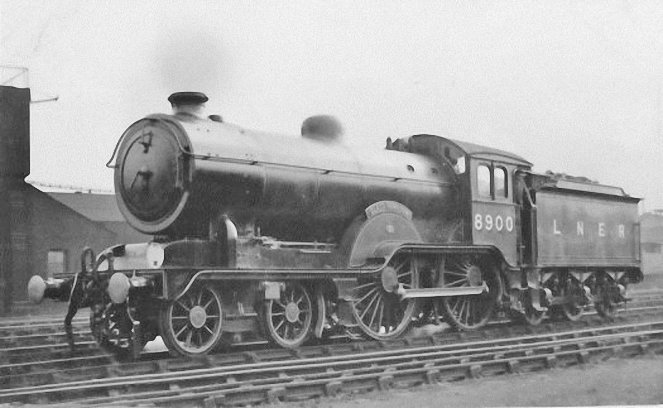 W. Clark 137/GERSHC 7069/24
W. Clark 137/GERSHC 7069/24
Following on from the successful rebuilding of the B-12 (ex-S69) 4-6-0s to class B-12/3, with new round-topped boilers and long valve-travel, a similar scheme was proposed to modernise the 4-4-0s. The first such rebuild to appear was 8848 in 1933, which retained its original slide valves. However, the next one to be dealt with was No. 8900 Claud Hamilton itself as seen in the photograph, which received new piston valve cylinders with longer valve-travel. New LNER-style cabs had to be fitted to suit the larger boiler, and decorative valancing was removed and the footplating simplified as shown. Further rebuilds quickly followed, ten of which received new cylinders and valves, and whether or not this was the case depended upon the condition of the original cylinders at the time of rebuilding. The rebuilds were all designated as class D-16/3, irrespective of whether they had piston valves or not. As demonstrated by the rebuilding of 8900, this time the new pattern of boiler could also be fitted to the ex-S46 class engines with further modification to the frames. By this period all of the ex-S46 class had been rebuilt as class D-15, so the D-14 class was officially extinct. However, the designation D-14/2 was originally used for the rebuilt No. 8900 and others from the S46 group. However, all were later regarded as D-16/3s. As rebuilding continued a further ten were fitted with piston valves of larger diameter, improved steam passages and other minor detail alterations. However, it became apparent that the enhanced power output of the piston valve cylinders was a little more than the 20-30 year old frames could bear, for cracking of the frames became common on these engines. It was therefore decided that all subsequent rebuilds would retain their slide valves.
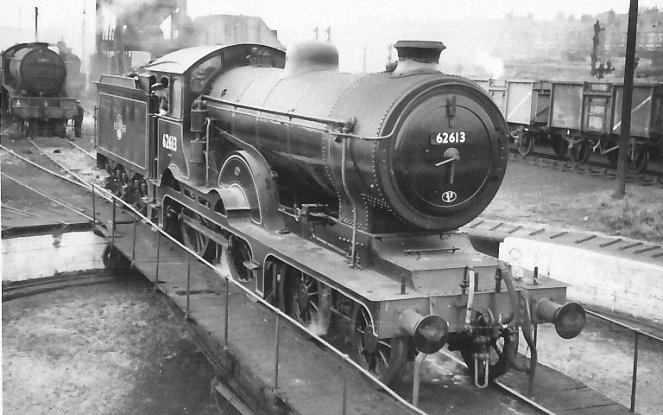 W.J. Naughton/GERSHC 7018/67
W.J. Naughton/GERSHC 7018/67
From 1938 those engines from the D-16/2 class were also rebuilt to D-16/3. As these locomotives already had wider cabs and rear splashers of GER pattern these were retained, together with the footplating and valances, as demonstrated here by 62613 (ex-H88 1782) in the late BR period. Again, they were classified D-16/3, irrespective of cab type. One engine – ‘Royal’ locomotive 8783 was damaged in the Hilgay accident in 1939, at which time it was still a D-16/2. When it was repaired it was rebuilt to D-16/3 at the same time, and as the cab and footplating were badly damaged it had the same pattern of new cab and footplating as the rebuilds from D-15.
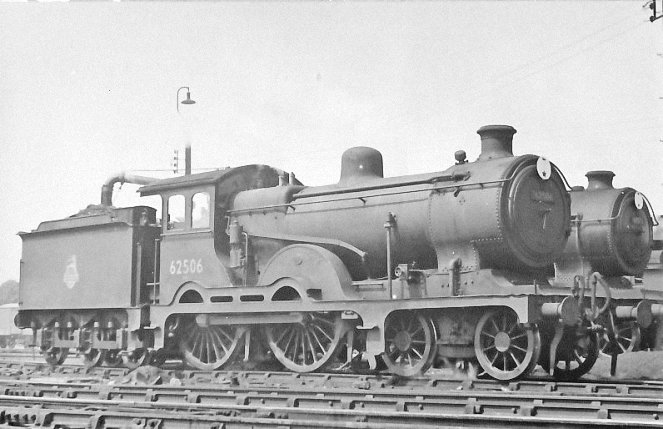 GERS Collection 7018/46
GERS Collection 7018/46
Following the Second World War the ‘Clauds’ were allocated the numbers 2500-2620 under the 1946 renumbering scheme. However, withdrawal had commenced the year before, and four locomotives had been scrapped by Nationalisation. All were D-16/3s, three of them from the piston valve rebuilds, including the class prototype Claud Hamilton itself. The nameplates were then transferred to 2546 (ex-8855) and carried until it was scrapped in 1957. Of the 117 locomotives that became BR property, 92 had been rebuilt as D-16/3s, and the rebuilding continued into 1949, a further twelve engines being dealt with. The photograph shows one of the un-rebuilt D-15/2s in final BR condition. This is No. 62506 (ex-8895) which survived until 1952 when the remainder of the D-15/2s were scrapped.
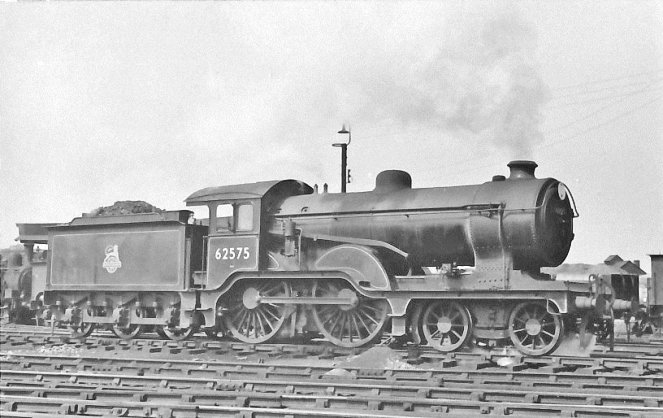 GERS Collection 7018/44
GERS Collection 7018/44
The D-16/3s continued to give good service throughout the 1950s. Four remained in traffic in 1960, and No. 62613 was the last to be withdrawn from service, in October. The photograph shows 62575 (ex-8824), one of the slide-valve engines, which lasted until 1957.
